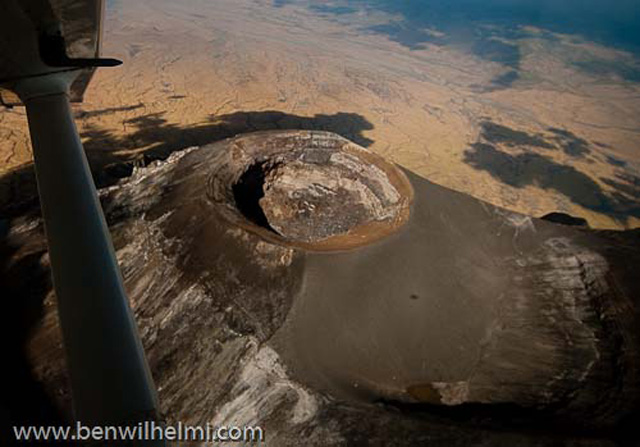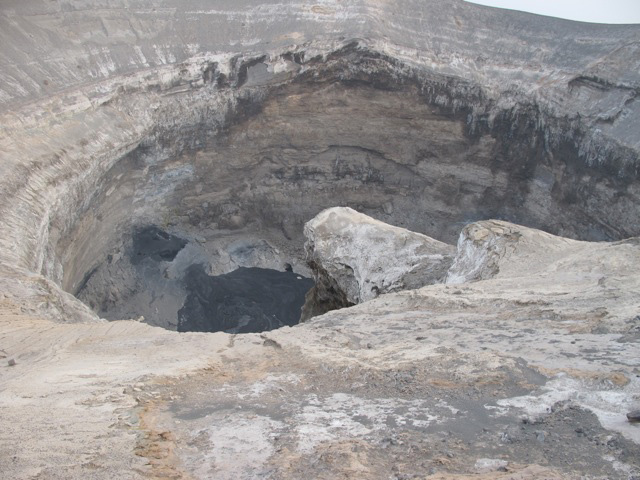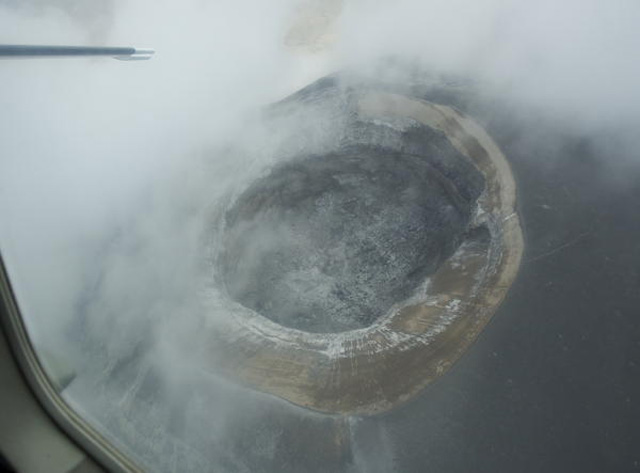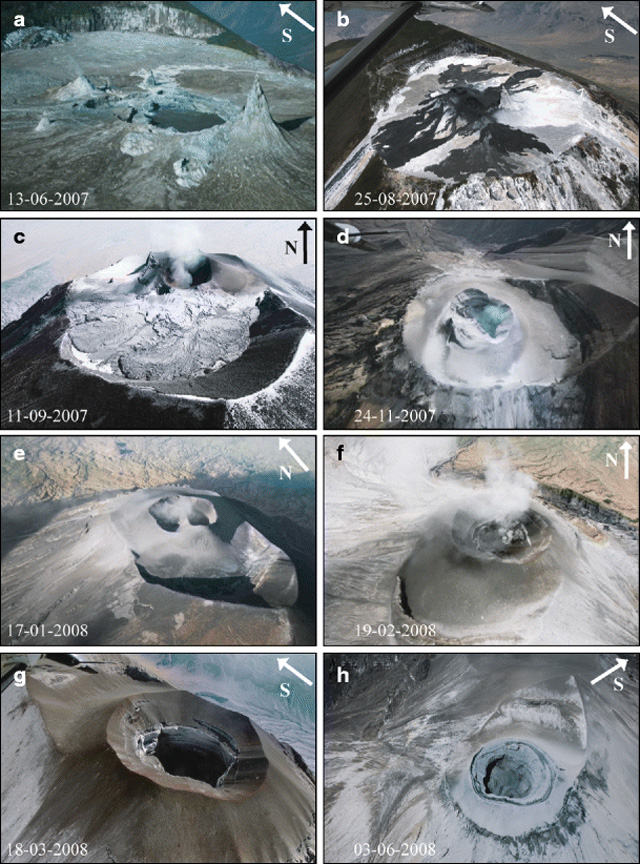Report on Ol Doinyo Lengai (Tanzania) — January 2012
Bulletin of the Global Volcanism Network, vol. 37, no. 1 (January 2012)
Managing Editor: Richard Wunderman.
Ol Doinyo Lengai (Tanzania) Update on observations; new reports on 2007-2008 eruptions
Please cite this report as:
Global Volcanism Program, 2012. Report on Ol Doinyo Lengai (Tanzania) (Wunderman, R., ed.). Bulletin of the Global Volcanism Network, 37:1. Smithsonian Institution. https://doi.org/10.5479/si.GVP.BGVN201201-222120
Ol Doinyo Lengai
Tanzania
2.764°S, 35.914°E; summit elev. 2962 m
All times are local (unless otherwise noted)
This report on Ol Doinyo Lengai (hereafter, Lengai) is a continuation of previous Bulletin reports that were based in part on those found on Frederick Belton's Lengai web site (Belton, 2012). Our last report was in September 2010 (BGVN 35:09). Figures 149 and 150 show aerial photographs of Lengai in late 2010.
 |
Figure 149. Aerial photo of the N crater of Lengai, looking NE, in late November 2010. Courtesy of Ben Wilhelmi; from Belton (2012). |
On 22 June 2011, Hans Schabel took a group of 8 conservation biologists to the Lengai summit up the regular approach along the NNW trail through the Pearly Gates (PG). During the ascent, the weather was cold, worsened by strong, increasingly sulfurous gusts from above. Minor fumaroles produced small clouds just above the PG. At the summit, conditions were relatively clear, making details of the crater rim and the pit visible. The slump on the E crater that Schabel first saw on his previous climb (16 January 2010, BGVN 35:05) had not expanded significantly, but some of the walls of the crater below had obviously slumped into big piles of rubble below. The group heard a 'whoosh' from two boiling, rolling, lava pools that spilled pitch-black lava into a growing lake flowing E in the crater floor (figure 151).
 |
Figure 151. Lava lake seen at the bottom of Lengai's N Crater (photo looking N), 22 June 2011. Courtesy of Hans Schabel; from Belton (2012). |
New Reports. Two recent research papers have been published concerning the 2007-2008 explosive eruptions of Lengai (BGVN 32:11, 33:02, 33:06, 33:08, 34:02, and 34:05). Kervyn and others (2010) and Keller and others (2010) summarize the first relatively closely documented 'cycle' from natrocarbonatite to carbonated nephelinite at Lengai. According to Kervyn and others (2010), on 4 September 2007, after 25 years of effusive natrocarbonatite eruptions, the eruptive activity of Lengai changed abruptly to episodic explosive eruptions. This transition was preceded by a voluminous lava eruption in March 2006, a year of quiescence, resumption of natrocarbonatite eruptions in June 2007, and a volcano-tectonic earthquake swarm in July 2007.
Keller and others (2010) noted that, with its paroxysmal ash eruption on 4 September 2007 and the highly explosive activity continuing in 2008, Lengai dramatically changed its behavior, crater morphology (figure 152), and magma composition after 25 years of quiet extrusion of fluid natrocarbonatite lava. This explosive activity resembled the explosive phases of 1917, 1940-1941, and 1966-1967, which were characterized by mixed ashes with dominantly nephelinitic and natrocarbonatitic components. Chemical analyses of the erupted products showed that the 2007-2008 explosive eruptions were associated with an undersaturated carbonated silicate melt. This new phase of explosive eruptions provided constraints on the factors causing the transition from natrocarbonatite effusive eruptions to explosive eruptions of carbonated nephelinite magma, variations observed repetitively in the last 100 years at Lengai.
Table 25 gives the summary of historical activity of Lengai from Keller and others (2010). The table shows the repeated occurrence of explosive paroxysms with documented or inferred natrocarbonatite activity in between the explosive eruptions.
Table 25. Synopis of the historical activity of Lengai, with observations covering about 100 years (since 1904 to 2008). References cited in the table are listed in the 'References to Table 25' section at the end of this Bulletin report. From Keller and others (2010).
| Date(s) | Observations (references) |
| ca. 1880 | First reports by early explorers: "Snow on the summit, Smoke at the summit." Volcanic activity reported by local people (Fischer, 1885; Neumann, 1894). |
| 1904 | First ascent by F. Jaeger (Uhlig, 1905) |
| 1913 | "Sodaschlammströme" (Reck and Schulze, 1921), from this inferred, effusive natrocarbonatite activity. Hornito morphology changed between photographs taken 1904 and 1915. Geological record: carbonatite platform below 1917 nephelinites (Keller and Krafft, 1990; Zaitsev and others, 2008a). |
| 1917 | Major explosive eruption. Ash eruptions, nephelinite lavas, and agglomerates. Geological record: nephelinite lavas and agglomerates above carbonatite platform forming the western and eastern crater rim before the 2007/2008 events. |
| 1921, 1926 | Eruption reports for 1921, 1926 classified as "minor" (Barns, 1921; Richard, 1942). |
| 1940-41 | Explosive eruption. "Soda-rich ashes" (Richard, 1942). Geological record: "Surge-series" bracketed between 1917 and 1966/1967 pyroclastics in the summit area. Ashes, spherical lapilli, bomb field. Ashes mixed of silicate and carbonatite components. |
| 1954/1955 | Explosive eruption classified as "minor" (Guest, 1956). |
| 1960 | Effusive activity. First recognition and analysis of natrocarbonatites (Dawson, 1962). |
| 1966-67 | Explosive eruptions (Dawson and others, 1968, 1992). "Mixed ashes." Geological record: "Grey series" ashes with spherical CWN lapilli on all slopes of the cone. Re-interpretation of the "Footprint Tuff" of Hay, 1983. |
| mid-1967 to 1983 | Reported quiescence. |
| 1983-88 | Minor explosive eruption, probably natrocarbonatitic (Nyamweru, 1997). |
| 1988-2007 | Regularly documented effusive natrocarbonatite activity (Nyamweru, 1990; Keller and Krafft, 1990; Dawson and others, 1990, 1995; Keller and others, 2007; Kervyn and others, 2008). |
| 04 Sep 2007 | Explosive paroxysm. |
| 2007-08 | Since 4 Sep 2007 through early 2008, explosive eruptions with plumes over 10 km. Geological record: ashes, lapilli and scoriae of carbonated combeite-wollastonite-melilite nephelinite. |
References. Belton, F., 2012, Mountain of God (URL: http://oldoinyolengai.pbworks.com/w/page/33191422/Ol Doinyo Lengai2C The Mountain of God).
Keller, J., Klaudius, J., Kervyn, M., Ernst, G.G.J., and Mattsson, H.B., 2010, Fundamental changes in the activity of the natrocarbonatite volcano Oldoinyo Lengai, Tanzania: I. New magma composition during the 2007-2008 explosive eruptions, Bulletin of Volcanology, v. 72, no. 8, pp. 893-912. DOI 10.1007/s00445-010-0371-x.
Kervyn, M., Ernst, G.G.J., Keller, J., Vaughan, R.G., Klaudius, J., Pradal, E., Belton, F., Mattsson, H.B., Mbede, E., and Jacobs, P., 2010, Fundamental changes in the activity of the natrocarbonatite volcano Oldoinyo Lengai, Tanzania: II. Eruptive behaviour during the 2007-2008 explosive eruptions, Bulletin of Volcanology, v. 72, no. 8, pp. 913-931. DOI 10.1007/s00445-010-0360-0.
Klaudius, J., and Keller, J., 2006, Peralkaline silica lavas at Oldoinyo Lengai, Tanzania, Lithos, v. 91, no. 1-4, pp. 173-190.
Mattsson, H.B., and Reusser, E., 2010, Mineralogical and geochemical characterization of ashes from an early phase of the explosive September 2007 eruption of Oldoinyo Lengai (Tanzania), Journal of African Earth Sciences, v. 58, no. 5, pp. 752-763.
Wiedenmann, D., Keller, J., and Zaitsev, A.N., 2010, Melilite-group minerals at Oldoinyo Lengai, Tanzania, Lithos, v. 118, no. 1-2, pp. 112-118.
References to Table 25. Barns, T.A., 1921, The highlands of the Great Craters, Tanganyika Territory, Geographic Journal, v. 58, pp. 401-416.
Dawson, J.B., 1962, The geology of Oldoinyo Lengai, Bulletin of Volcanology, v. 24, pp. 348-387.
Dawson, J.B., Bowden, P., and Clark, G.C., 1968, Activity of the carbonatite volcano Oldoinyo Lengai, 1966, Geol Rundsch, v. 57, pp. 865-879.
Dawson, J.B., Pinkerton, H., Norton, G.E., and Pyle, D., 1990, Physicochemical properties of alkali carbonatite lavas: data from the 1988 eruption of Oldoinyo Lengai, Tanzania, Geology, v. 18, pp. 260-263.
Dawson, J.B., Smith, J.V., and Steele, I.M., 1992, 1966 ash eruption of the carbonatite volcano Oldoinyo Lengai: mineralogy of lapilli and mixing of silicate and carbonate magmas, Mineralogical Magazine, v. 56, pp. 1-16.
Dawson, J.B., Keller, J., and Nyamweru, C., 1995, Historic and recent eruptive activity of Oldoinyo Lengai. In: Bell K, Keller J (eds) Carbonatite volcanism: Oldoinyo Lengai and the petrogenesis of natrocarbonatites, IAVCEI Proceedings on Volcanology, v. 4. Springer, Berlin, pp. 4-22.
Fischer, G.A., 1885, Bericht über die im Auftrage der Geographischen Gesellschaft in Hamburg unternommene Reise in das Masai-Land 1882-1883. II: Begleitworte zur Original-Routenkarte, Mitt Geogr Ges Hamburg 1885, pp. 189-237.
Guest, N.J., 1956, The volcanic activity of Oldoinyo L'Engai, 1954, Rec Geol Surv Tanganyika, v. 4, pp. 56-59.
Hay, R.L., 1983, Natrocarbonatite tephra of Kerimasi volcano, Tanzania, Geology, v. 11, pp. 599-602.
Keller, J., and Krafft, M., 1990, Effusive natrocarbonatite activity of Oldoinyo Lengai, June 1988, Bulletin of Volcanology, v. 52, pp. 629-645.
Keller, J., Zaitsev, A.N., and Klaudius, J., 2007, Geochemistry and petrogenetic significance of natrocarbonatites at Oldoinyo Lengai, Tanzania: composition of lavas from 1988 to 2007, Goldschmidt Conference 2007, Cologne, Abstracts.
Kervyn, M., Klaudius, J., Keller, J., Kervyn, F., Mattsson, H., Belton, F., Mbede, E., Jacobs, P., and Ernst,G.G.J., 2008, Voluminous lava floods at Oldoinyo Lengai in 2006: chronology of events and insights into the shallow magmatic system. Bulletin of Volcanology, v. 70, pp. 1069-1086.
Neumann, O., 1894, In: Matschie, P., Nachrichten aus den deutschen Schutzgebieten. Deutsch-Ostafrika. Von der wissenschaftlichen Expedition Oskar Neumanns, Deutsches Kolonialblatt, v. 21, pp 421-424.
Nyamweru, C. 1990, Observations on changes in the active crater of Oldoinyo Lengai from 1960 to1988, Journal of African Earth Sciences, v. 11, pp. 385-390.
Nyamweru, C., 1997, Changes in the crater of Oldoinyo Lengai, Journal of African Earth Sciences, v. 25, pp. 43-53.
Reck, H., and Schulze, G., 1921, Ein Beitrag zur Kenntnis des Baues und der jüngsten Veränderung des L'Engai Vulkans im nördlichen Deutsch-Ostafrika, Z Vulk, v. 6, pp. 47-71.
Richard, J.J., 1942, Volcanological observations in East Africa. I Oldoinyo Lengai. The 1940-1 eruption, Journal of East Africa Uganda Natural Historical Society, v. 16, pp. 89-108.
Uhlig, C., 1905, Bericht über die Expedition der Otto-Winter-Stiftung nach den Umgebungen des Meru. Zeitschrift der Gesellschaft für Erdkunde zu Berlin, Jg 1905, pp. 120-123.
Zaitsev, A.N., Keller, J., Spratt, J., Perova, E.N., and Kearsley, A., 2008a, Nyerereite-pirssonite-calcite-shortite relationships in altered natrocarbonatites, Oldoinyo Lengai, Tanzania, Canadian Mineralogy, v. 46, pp. 1077-1094.
Zaitsev, A.N., Keller, J., Spratt, J., Jeffries, T.E., and Sharigin, V.V., 2008b, Chemical composition of nyerereite and gregoryite in natrocarbonatites of Oldoinyo Lengai Volcano, Tanzania, Procedings of the Russian Mineralogical Society, v. 137, pp. 101-111.
Geological Summary. The symmetrical Ol Doinyo Lengai is the only volcano known to have erupted carbonatite tephras and lavas in historical time. The prominent stratovolcano, known to the Maasai as "The Mountain of God," rises abruptly above the broad plain south of Lake Natron in the Gregory Rift Valley. The cone-building stage ended about 15,000 years ago and was followed by periodic ejection of natrocarbonatitic and nephelinite tephra during the Holocene. Historical eruptions have consisted of smaller tephra ejections and emission of numerous natrocarbonatitic lava flows on the floor of the summit crater and occasionally down the upper flanks. The depth and morphology of the northern crater have changed dramatically during the course of historical eruptions, ranging from steep crater walls about 200 m deep in the mid-20th century to shallow platforms mostly filling the crater. Long-term lava effusion in the summit crater beginning in 1983 had by the turn of the century mostly filled the northern crater; by late 1998 lava had begun overflowing the crater rim.
Information Contacts: Frederick Belton, Developmental Studies Department, PO Box 16, Middle Tennessee State University, Murfreesboro, TN 37132, USA (URL: http://oldoinyolengai.pbworks.com/); Laura Carmody, Department of Earth Science, University College London, Gower Street, London, WC1E 6BT, United Kingdom; Michael Dalton-Smith, Digital Crossing Productions (URL: http://digitalcrossing.ca/); Adrian P. Jones, Department of Earth Science, University College London, Gower Street, London, WC1E 6BT, United Kingdom; Sonja Joplin, One Heart Source (URL: http://www.oneheartsource.org); Matthew J. Genge, Department of Earth Science and Engineering, Royal School of Mines, Prince Consort Road, Imperial College London, SW7 2BP United Kingdom; Wendy Nelson, Department of Terrestrial Magnetism, Carnegie Institution of Washington, 5241 Broad Branch Rd, NW Washington, DC 20015, USA; Hans Schabel, retired forestry professor; Dave Simpson, Dave Simpson, professional guide, Kenya, East Africa (URL: http://www.davesimpsonsafaris.com); Ben Wilhelmi, commercial pilot (URL: http://benwilhelmi.typepad.com/benwilhelmi/).



